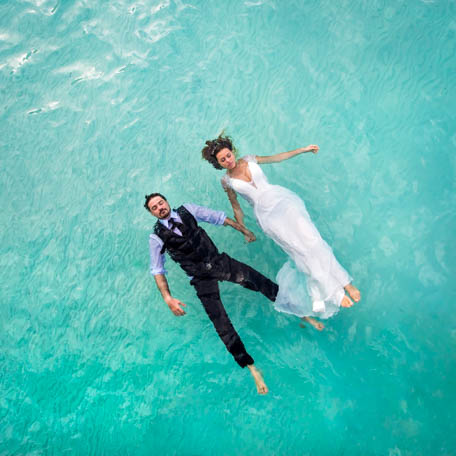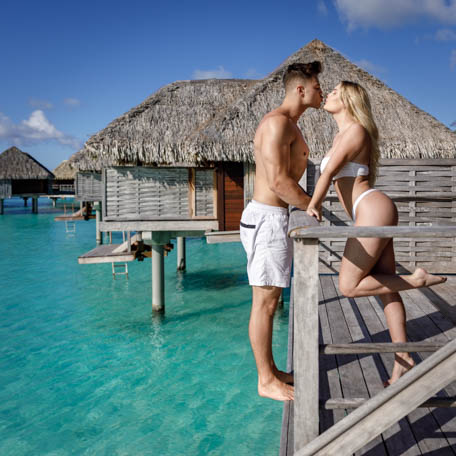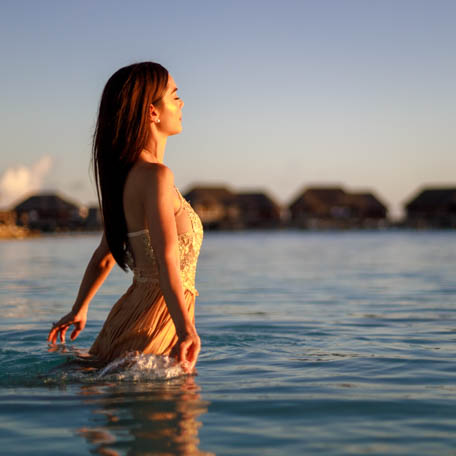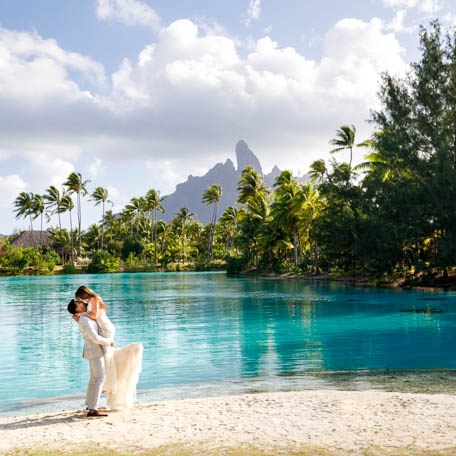Bora Bora is one of a few places in the world where you have 100% chances to swim with sharks because shark feeding is involved in most of the snorkel tours and dive sites. As we have been living here for 10 years, we want to give you the real understanding and all the implications, without being biased. (I’m not here to sell you a tour anyway)
Fascinating due to its beauty and feared for its reputation as a bloodthirsty man-eater, the shark leaves no one unscathed. As a symbol of French Polynesia, this creature occupies a privileged space in the culture and coral ecosystems as well as plays a major role in Bora Bora tourism.
Why such a bad reputation?
Over the years, sharks have gotten the worst reputation. However, I recommend you to take a second look at these magnificent creatures and consider fighting fear with facts.
I believe that all started when Jaws was first brought to life by Peter Benchley as a novel in 1974 before being turned into the iconic blockbuster the following year by Steven Spielberg with a screenplay co-written by Benchley.
In his final years Benchley became an advocate for shark conservation and began speaking out against sensationalizing shark attacks, the very practice he had built a career on. According to his obituary in the Los Angeles Times, Benchley admitted the harm that Jaws had done.
“Knowing what I know now, I could never write that book today. Sharks don’t target human beings, and they certainly don’t hold grudges,” he said .
Are sharks a threat for humans?
No! In fact, your chances of being the victim of an unprovoked shark encounter are lower than your chances of being struck by lighting, injured in a hunting accident or even attacked by a domestic dog. Like they said in French Polynesia, you are much more likely to be injured from a coconut falling on top of your head than from a shark. this fear of the shark is also linked to the fascination exerted by this indomitable, solitary and ruthless animal that has dominated the oceans for more than 350 million years. In Polynesia, the image of the ma’o was quite different: the Polynesians, drawing a large part of their resources from the lagoon and the ocean, we quickly coast, recognized and respected the different types of sharks. The elders honored and revered the shark, considering everything to be a confidant, a protector and sometimes the reincarnation of a loved one gone to sea. While Western stories described terrifying scenes of encounters with sea monsters, the Polynesians as for them, gave them a lot of respect. Shark attacks in French Polynesia are rare and are always the result of shark scorn or dubious behavior by humans. Whatever the activity practiced, rules can eliminate any danger.
Are humans a threat for sharks?
Yes! It turns out that sharks have more reason to fear humans than the other way around. Every year, the fins of between 26 and 73 million sharks are traded in markets around the world. Far more are likely killed at sea, though we will never know just how many. The threats we pose are many. By catch: the accidental killing of sharks in fishing gear intended for other species. Illegal poaching and hunting: selling shark fins for soup and sport-fishing for shark-jaw trophies. Without forgetting the nets: placed along coastlines to keep sharks away from beaches.
As a result many shark species are endangered, with their endangered status threatening not only their well being but also that of the entire ecosystem.
What happens if sharks disappear?
As top predators, imbalance in the shark population causes the food chain to become unstable, biodiversity suffers. Sharks have served as the caretakers of the sea by removing sick, injured, and deceased animals, therefore keeping the ocean clean and marine life populations healthy. While sharks are highly effective predators, they can equally be viewed as mere scavengers that would rather target an easy, weak prey over a healthy animal. As a keystone species, sharks are instrumental in maintaining a balanced ecosystem. Without the presence of sharks, a devastating domino effect would impact populations throughout the food chain.
Perhaps we too often look down at the dark side of sharks rather than up at the light where the positive impacts they have on our ocean are clearly visible. If we choose to view sharks from a different angle, perhaps fear will fade in favor of wonder and admiration for one of the ocean’s oldest caretakers. As we learn more about sharks and dispel age-old myths, the greater our appreciation, understanding, and respect will be for their rightful place in nature and cultural beliefs.
French Polynesia, a shark sanctuary
In 2006 the alarming decline in the numbers of sharks prompted French Polynesian authorities to decree a partial protection of sharks. By 2012, the law included total protection of sharks throughout the vast territory. All shark fishing is prohibited as well as the commercialisation of any products derived from sharks, such as shark tooth necklaces. Buying these products, which are sometimes still for sale in French Polynesia, is a crime.
Types of sharks in Bora Bora
The blacktip shark
The vaki or “Ma’o Mauri” in Tahitian, the small blacktip reef shark (C. melanopterus) Generally greyish/brownish with a white belly, present in the 5 French Polynesia archipelagos and are certainly the most common specie in our Polynesian lagoons.
Easily recognised for their black dorsal fin, which is exposed above the water. The blacktips shark measures an average from 3ft to 4ft for a maximum of 6.5ft.
Quite timid and fearful, the blacktips shark is considered “less scary” than the others sharks.
Lemon sharks
In Bora Bora’s snorkel or diving tours you also have the opportunity to come across the ’arava, or sickle-fin lemon shark (Negaprion acutidens), which can reach an imposing size greater than 10ft. This shark is impressive, yet reserves his sharp teeth for fish.
Where can I encounter sharks in Bora Bora?
Close to your resort? Very unlikely! The overwater bungalow are suspended in very shallow water inside the lagoon and the sharks won’t venture anywhere close. The only sharks that you can see in shallow water are tiny very and shy baby black tip sharks of less than 50 cm-20 inches. (Disclaimer, the featured image of this article where you can see sharks swimming under the bungalow is a PhotoShop montage)
To see the sharks you will have to take a boat excursion. The most popular snorkel sites to encounter sharks are:
- Diving and snorkeling Site Tapu Ocean side /20mn boat ride Mooring depth : 30 feet. Maximum depth : 130 feet. Exiting the pass, one of the most famous sites of Bora Bora. From the coral drop-off, you will meet lemon sharks, black tip sharks, humphead maori wrasses, moray eels and if you are lucky : turtles.
- Stingray Station Inside the lagoon /20 mn boat ride. Shallow water where you can stand up. You will meet southern stingrays and small black tip sharks.
If you are a certified diver you have chances to see sharks while scuba-diving. Click here to know the most popular scuba-diving sites.
Can you go swimming with the sharks on your period?
Yes, don’t be afraid to go for a swim with the sharks if you are on your period. Sharks are simply not attuned to sniffing out human blood because humans are not part of their diet. Most sharks eat other fish so that is what their senses are designed to recognize. In addition, the amount of blood that could be released into the water by a woman swimming while menstruating is very small.
The debate around shark feeding in Bora Bora?
The truth is that the sharks that you are going to see in Bora Bora is because shark feeding had make them familiar with some snorkel and dive sites where tour operators feed sharks and stingrays with small dead fish.
So should we support shark feeding?
This topic has been controversial for several years.
Let’s compare the pros and cons of shark feeding along with some supporting information for each side.
Cons to shark feeding in Bora Bora
Although sharks are generally harmless, repeatedly being fed by humans, sharks begin associating food with humans and tour boats.
When sharks start to do this it becomes a concern that shark feeding will change and possibly even cause sharks to lose their innate eating habits.
Even very small, there’s always the chance that somebody could accidentally get bitten by an over-zealous shark in the heat of the moment (just like with any wild animal).
Pros to shark feeding in Bora Bora
Spreads awareness about the safety of sharks and their habitat.
Might help in the fight against shark fishing.
Some say that by feeding them a little, they just arrive at the feeding point being curious, simply wanting a taste of the food. This way their normal food habit is not totally being changed.
Change your point of view and make you reconsider them as a noble animal instead of a man eater. The observation of sharks makes it possible to know them better and to respect them.
Sharks attacks in Bora Bora
In French Polynesia’s, there has not been a deadly shark attack in over 50 years.
But it’s important to realize that having a degree of fear of sharks is a natural reaction. Sharks are predators and have the potential to be dangerous in certain situations just like any other wild animal.
But considering the vast number of people swimming with sharks in the lagoon of Bora Bora, every day, it is clear that any negative interactions with sharks are rare anomalies.
Rare shark bites involve upper limbs and are often through human error experienced by people who had the poor judgement to try and feed the sharks themself by hand.
If you have consider pros and cons and you go on a tour please don’t stick your hand out to try to pet them, don’t wear shiny jewellery when in the water with them, and of course don’t feed them.
Looking for an alternative?
Manta Rays in Bora Bora
Bora Bora is also one of the few places in the world where you can see a ballet of Manta rays. Majestic animals, not to be confused with sting ray and eagle ray (also possible to spot in the island) they are even more impressive and totally harmless. Manta rays just feed on tiny marine organisms including microscopic plankton, small fish and crustacean. Average size commonly observed is 45 ft (4.5 m)
Snorkel or “Discover Scuba Diving” in the Coral Gardens
Some operators in the island that don’t support shark and ray feeding offer alternatives as snorkel tours to beautiful coral gardens. You can even try “Discover Scuba Diving” a short try-diving experience that introduces you to the basics of scuba diving, and doesn’t require a certification. Is a half-day activity, so it’s a great option for an easy, shallow dive in the lagoon. And don’t forget your underwater camera! (learn more about underwater photography here)
Whale watching
Every year over the same time period, humpback whales come to French Polynesia from Antarctica. The first few are sighted in June and the last ones depart our islands in early December. The peak season is between mid-August and the end of October. Tahiti and her Islands has been designated as a sanctuary for these mammals.







